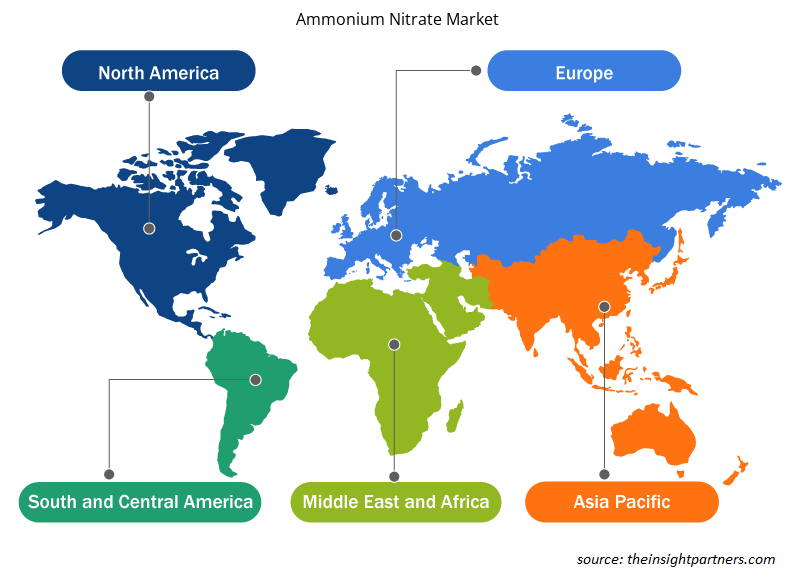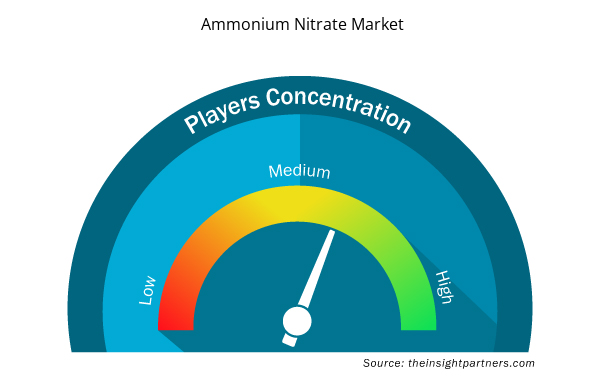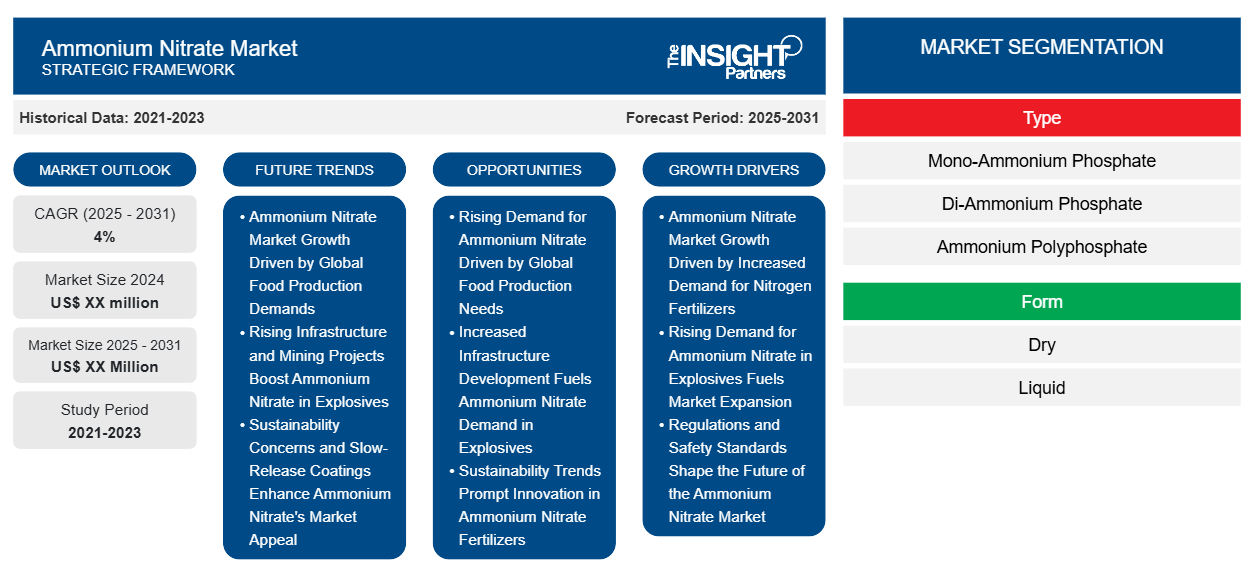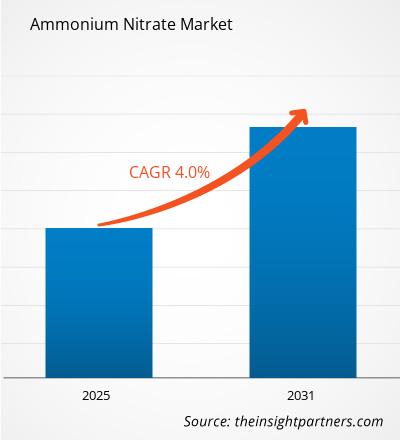Es wird erwartet, dass der Ammoniumnitratmarkt von 2024 bis 2031 eine durchschnittliche jährliche Wachstumsrate (CAGR) von 4 % verzeichnet, wobei die Marktgröße von XX Millionen US-Dollar im Jahr 2024 auf XX Millionen US-Dollar bis 2031 wächst.
Der Bericht ist nach Typ (Monoammoniumphosphat (MAP), Diammoniumphosphat (DAP), Ammoniumpolyphosphat) segmentiert. Der Bericht präsentiert außerdem Analysen basierend auf der Form (trocken und flüssig). Die globale Analyse ist weiter auf regionaler Ebene und in die wichtigsten Länder unterteilt. Die Marktgröße und -prognose auf globaler, regionaler und Länderebene für alle wichtigen Marktsegmente werden im Rahmen des Berichts abgedeckt. Der Bericht bietet den Wert in USD für die oben genannte Analyse und die Segmente. Der Bericht bietet wichtige Statistiken zum Marktstatus der wichtigsten Marktteilnehmer und bietet Markttrends und -chancen.
Zweck des Berichts
Der Bericht Ammoniumnitratmarkt von The Insight Partners zielt darauf ab, die aktuelle Situation und das zukünftige Wachstum sowie die wichtigsten treibenden Faktoren, Herausforderungen und Chancen zu beschreiben. Dies wird verschiedenen Geschäftspartnern Einblicke geben, wie zum Beispiel:
- Technologieanbieter/-hersteller: Um die sich entwickelnde Marktdynamik zu verstehen und die potenziellen Wachstumschancen zu kennen, damit sie fundierte strategische Entscheidungen treffen können.
- Investoren: Durchführung einer umfassenden Trendanalyse hinsichtlich der Marktwachstumsrate, der finanziellen Marktprognosen und der Chancen entlang der Wertschöpfungskette.
- Regulierungsbehörden: Zur Regulierung von Richtlinien und Überwachungsaktivitäten auf dem Markt mit dem Ziel, Missbrauch zu minimieren, das Vertrauen der Anleger zu bewahren und die Integrität und Stabilität des Marktes aufrechtzuerhalten.
Ammoniumnitrat Marktsegmentierung
Typ
- Monoammoniumphosphat
- Di-Ammoniumphosphat
- Ammoniumpolyphosphat
Bilden
- Trocken
- Flüssig
Passen Sie diesen Bericht Ihren Anforderungen an
Sie erhalten kostenlos individuelle Anpassungen an jedem Bericht, einschließlich Teilen dieses Berichts oder einer Analyse auf Länderebene, eines Excel-Datenpakets sowie tolle Angebote und Rabatte für Start-ups und Universitäten.
- Holen Sie sich die wichtigsten Markttrends aus diesem Bericht.Dieses KOSTENLOSE Beispiel umfasst eine Datenanalyse von Markttrends bis hin zu Schätzungen und Prognosen.
Wachstumstreiber auf dem Ammoniumnitratmarkt
- Ammoniumnitrat-Marktwachstum durch gestiegene Nachfrage nach Stickstoffdüngern getrieben: Der Ammoniumnitrat-Markt wird vor allem durch seine weit verbreitete Verwendung als Stickstoffdünger getrieben. Angesichts der wachsenden Weltbevölkerung und des Bedarfs an erhöhter Nahrungsmittelproduktion verlassen sich Landwirte zunehmend auf Ammoniumnitrat, um die Ernteerträge zu steigern. Seine Wirksamkeit als schnell freisetzende Stickstoffquelle macht es zu einer bevorzugten Wahl, was zu einem robusten Marktwachstum führt.
- Steigende Nachfrage nach Ammoniumnitrat in Sprengstoffen – Marktexpansion: Ammoniumnitrat ist ein wichtiger Bestandteil bei der Herstellung von Sprengstoffen für Bergbau, Bau und Abbruch. Da Infrastrukturprojekte und Bergbauaktivitäten weltweit expandieren, steigt die Nachfrage nach Ammoniumnitrat in Sprengstoffen. Diese Doppelrolle als Düngemittel und Sprengstoffvorläufer treibt das erhebliche Wachstum des Ammoniumnitratmarktes voran.
- Vorschriften und Sicherheitsstandards bestimmen die Zukunft des Ammoniumnitratmarktes: Zunehmende Vorschriften für den Umgang und die Lagerung von Ammoniumnitrat, insbesondere in der Sprengstoffindustrie, beeinflussen die Marktdynamik. Hersteller investieren in sicherere Produktions- und Vertriebsmethoden, um diese Vorschriften einzuhalten. Wenn Unternehmen sicherere Praktiken einführen, kann es auf dem Markt zu Veränderungen der Nachfragemuster und Produktinnovationen kommen.
Zukünftige Trends auf dem Ammoniumnitratmarkt
- Wachstum des Ammoniumnitratmarktes wird durch die globale Nachfrage nach Nahrungsmittelproduktion vorangetrieben: Der Ammoniumnitratmarkt wird ein signifikantes Wachstum erleben, insbesondere durch den unaufhörlichen Drang, die Nahrungsmittelproduktion weltweit zu steigern. Die Herausforderungen, die mit dem Bevölkerungswachstum einhergehen, das durch die Urbanisierung gipfelt, führen zu einem großen Bedarf an wirksamen Düngemitteln, die in der Lage sind, die Ernteerträge der Landwirte zu steigern. Dies liegt daran, dass Ammoniumnitrat Stickstoff in einer Form enthält, die für die Nutzung durch Nutzpflanzen leicht verfügbar ist, und daher wird es für viele landwirtschaftliche Erzeuger das Produkt der Wahl bleiben und so das Wachstum dieses Marktes vorantreiben.
- Steigende Infrastruktur- und Bergbauprojekte erhöhen Ammoniumnitrat in Sprengstoffen: Da die Zahl der Infrastruktur- und Rohstoffentwicklungsprojekte weltweit steigt, wird die Verwendung von Ammoniumnitrat bei der Herstellung von Sprengstoffen für Bau und Bergbau voraussichtlich zunehmen. Auf diese Weise wird das Produkt „Avolatile Extreme Introduction“ sowohl als Düngemittel als auch als Füllstoff für den Benutzer für Investoren in der Produktion und im Verkauf von Ammoniumnitrat außerordentlich attraktiv.
- Nachhaltigkeitsbedenken und Beschichtungen mit langsamer Freisetzung erhöhen die Marktattraktivität von Ammoniumnitrat: Mit zunehmenden Umweltschutzbestimmungen richtet sich die Aufmerksamkeit nun auf die Verwendung wirksamer und sicherer Düngemittel. Beispielsweise wird die Einführung der Beschichtung mit langsam freisetzendem Ammoniumnitrat die Umwelt schützen und den Stickstoffeinsatz von Düngemitteln optimieren. Es ist dieses Nachhaltigkeitsbedenken, das mehr Benutzer für Ammoniumnitrat gewinnen und so die Aufnahme dieses Marktes erleichtern wird.
Marktchancen für Ammoniumnitrat
- Steigende Nachfrage nach Ammoniumnitrat aufgrund des Bedarfs an globaler Nahrungsmittelproduktion: Der Ammoniumnitratmarkt wächst, da mit der wachsenden Bevölkerung auch die Nachfrage nach Nahrungsmitteln steigt. Landwirte suchen nach besseren und effizienteren Düngemitteln, um ihre Ernteerträge zu steigern. Daher ist Ammoniumnitrat als Stickstoffquelle am gefragtesten und daher für die Hersteller eine konstante Nachfrage.
- Verstärkter Infrastrukturausbau treibt Nachfrage nach Ammoniumnitrat für Sprengstoffe an: Der Anstieg der Infrastrukturaktivitäten weltweit, insbesondere in den Ländern der Dritten Welt, dürfte auf dem Sprengstoffmarkt eine hohe Nachfrage nach Ammoniumnitrat erzeugen. Das Wachstum in der Bau- und Bergbauindustrie wird die Nachfrage nach wirksamen Sprengstoffen erhöhen und somit einen riesigen Markt für Ammoniumnitratlieferanten darstellen.
- Nachhaltigkeitstrends fördern Innovationen bei Ammoniumnitrat-Düngemitteln: Der Trend zur ökologischen Nachhaltigkeit in der Landwirtschaft hat die Chance geschaffen, bessere Alternativen zu Ammoniumnitrat zu entwickeln. Langsam freisetzende oder beschichtete Düngemittel beispielsweise sind Innovationen, die die Nährstoffeffizienz verbessern und die Umweltverschmutzung reduzieren können, was Landwirte und Agrarunternehmen für Verbraucher attraktiv macht.
Regionale Einblicke in den Ammoniumnitratmarkt
Die regionalen Trends und Faktoren, die den Ammoniumnitratmarkt während des gesamten Prognosezeitraums beeinflussen, wurden von den Analysten von Insight Partners ausführlich erläutert. In diesem Abschnitt werden auch die Marktsegmente und die Geografie des Ammoniumnitratmarkts in Nordamerika, Europa, im asiatisch-pazifischen Raum, im Nahen Osten und Afrika sowie in Süd- und Mittelamerika erörtert.

- Erhalten Sie regionale Daten zum Ammoniumnitratmarkt
Umfang des Ammoniumnitrat-Marktberichts
| Berichtsattribut | Details |
|---|---|
| Marktgröße im Jahr 2024 | XX Millionen US-Dollar |
| Marktgröße bis 2031 | XX Millionen US-Dollar |
| Globale CAGR (2024 - 2031) | 4 % |
| Historische Daten | 2021-2023 |
| Prognosezeitraum | 2025–2031 |
| Abgedeckte Segmente | Nach Typ
|
| Abgedeckte Regionen und Länder | Nordamerika
|
| Marktführer und wichtige Unternehmensprofile |
|
Dichte der Marktteilnehmer auf dem Ammoniumnitratmarkt: Die Auswirkungen auf die Geschäftsdynamik verstehen
Der Markt für Ammoniumnitrat wächst rasant, angetrieben durch die steigende Nachfrage der Endverbraucher aufgrund von Faktoren wie sich entwickelnden Verbraucherpräferenzen, technologischen Fortschritten und einem größeren Bewusstsein für die Vorteile des Produkts. Mit steigender Nachfrage erweitern Unternehmen ihr Angebot, entwickeln Innovationen, um die Bedürfnisse der Verbraucher zu erfüllen, und nutzen neue Trends, was das Marktwachstum weiter ankurbelt.
Die Marktteilnehmerdichte bezieht sich auf die Verteilung von Firmen oder Unternehmen, die in einem bestimmten Markt oder einer bestimmten Branche tätig sind. Sie gibt an, wie viele Wettbewerber (Marktteilnehmer) in einem bestimmten Marktraum im Verhältnis zu seiner Größe oder seinem gesamten Marktwert präsent sind.
Die wichtigsten auf dem Ammoniumnitratmarkt tätigen Unternehmen sind:
- CSBP GmbH
- Handelsmarke Stickstoff
- CF Industries Holdings Inc
- Orica GmbH
- Yara International ASA
- Uralchem
Haftungsausschluss : Die oben aufgeführten Unternehmen sind nicht in einer bestimmten Reihenfolge aufgeführt.

- Überblick über die wichtigsten Akteure auf dem Ammoniumnitratmarkt
Wichtige Verkaufsargumente
- Umfassende Abdeckung: Der Bericht deckt die Analyse von Produkten, Dienstleistungen, Typen und Endbenutzern des Ammoniumnitrat-Marktes umfassend ab und bietet einen ganzheitlichen Überblick.
- Expertenanalyse: Der Bericht basiert auf dem umfassenden Verständnis von Branchenexperten und Analysten.
- Aktuelle Informationen: Der Bericht stellt durch die Abdeckung aktueller Informationen und Datentrends Geschäftsrelevanz sicher.
- Anpassungsoptionen: Dieser Bericht kann angepasst werden, um spezifische Kundenanforderungen zu erfüllen und die Geschäftsstrategien optimal anzupassen.
Der Forschungsbericht zum Ammoniumnitratmarkt kann daher dabei helfen, die Branchensituation und Wachstumsaussichten zu entschlüsseln und zu verstehen. Obwohl es einige berechtigte Bedenken geben kann, überwiegen die allgemeinen Vorteile dieses Berichts tendenziell die Nachteile.
- Historische Analyse (2 Jahre), Basisjahr, Prognose (7 Jahre) mit CAGR
- PEST- und SWOT-Analyse
- Marktgröße Wert/Volumen – Global, Regional, Land
- Branche und Wettbewerbsumfeld
- Excel-Datensatz



Report Coverage
Revenue forecast, Company Analysis, Industry landscape, Growth factors, and Trends

Segment Covered
This text is related
to segments covered.

Regional Scope
North America, Europe, Asia Pacific, Middle East & Africa, South & Central America

Country Scope
This text is related
to country scope.
Häufig gestellte Fragen
Increasing agricultural productivity needs is expected to be the key market trends
Based on type, the mono-ammonium phosphate (MAP) segment is expected to witness the fastest growth during the forecast period
Based on geography, Asia Pacific held the largest share of the ammonium nitrate market due to the well-established agriculture industry across the region, coupled with continuous growth and development
Surge in fertilizer demand is driving the market growth
Yara International ASA; CF Industries Holdings, Inc.; Nutrien Ltd.; Orica Limited; Uralchem JSC; Terra Nitrogen Company, L.P.; BASF SE; K+S Aktiengesellschaft; Koch Industries, Inc.; Tessenderlo Group; Fertiberia S.A.; Shanxi Jincheng Anthracite Mining Group; Brevard Chemical Co.; Agrium Inc.; Indian Farmers Fertiliser Cooperative Limited (IFFCO)
The Ammonium Nitrate Market is estimated to witness a CAGR of 4% from 2023 to 2031
Trends and growth analysis reports related to Chemicals and Materials : READ MORE..
- CSBP Limited
- TradeMark Nitrogen
- CF Industries Holdings Inc
- Orica Limited
- Yara International ASA
- Uralchem
- Acron Group
- Enaex SA
- Maxam Corp Holding SL
- Sasol Limited
The Insight Partners performs research in 4 major stages: Data Collection & Secondary Research, Primary Research, Data Analysis and Data Triangulation & Final Review.
- Data Collection and Secondary Research:
As a market research and consulting firm operating from a decade, we have published and advised several client across the globe. First step for any study will start with an assessment of currently available data and insights from existing reports. Further, historical and current market information is collected from Investor Presentations, Annual Reports, SEC Filings, etc., and other information related to company’s performance and market positioning are gathered from Paid Databases (Factiva, Hoovers, and Reuters) and various other publications available in public domain.
Several associations trade associates, technical forums, institutes, societies and organization are accessed to gain technical as well as market related insights through their publications such as research papers, blogs and press releases related to the studies are referred to get cues about the market. Further, white papers, journals, magazines, and other news articles published in last 3 years are scrutinized and analyzed to understand the current market trends.
- Primary Research:
The primarily interview analysis comprise of data obtained from industry participants interview and answers to survey questions gathered by in-house primary team.
For primary research, interviews are conducted with industry experts/CEOs/Marketing Managers/VPs/Subject Matter Experts from both demand and supply side to get a 360-degree view of the market. The primary team conducts several interviews based on the complexity of the markets to understand the various market trends and dynamics which makes research more credible and precise.
A typical research interview fulfils the following functions:
- Provides first-hand information on the market size, market trends, growth trends, competitive landscape, and outlook
- Validates and strengthens in-house secondary research findings
- Develops the analysis team’s expertise and market understanding
Primary research involves email interactions and telephone interviews for each market, category, segment, and sub-segment across geographies. The participants who typically take part in such a process include, but are not limited to:
- Industry participants: VPs, business development managers, market intelligence managers and national sales managers
- Outside experts: Valuation experts, research analysts and key opinion leaders specializing in the electronics and semiconductor industry.
Below is the breakup of our primary respondents by company, designation, and region:

Once we receive the confirmation from primary research sources or primary respondents, we finalize the base year market estimation and forecast the data as per the macroeconomic and microeconomic factors assessed during data collection.
- Data Analysis:
Once data is validated through both secondary as well as primary respondents, we finalize the market estimations by hypothesis formulation and factor analysis at regional and country level.
- Macro-Economic Factor Analysis:
We analyse macroeconomic indicators such the gross domestic product (GDP), increase in the demand for goods and services across industries, technological advancement, regional economic growth, governmental policies, the influence of COVID-19, PEST analysis, and other aspects. This analysis aids in setting benchmarks for various nations/regions and approximating market splits. Additionally, the general trend of the aforementioned components aid in determining the market's development possibilities.
- Country Level Data:
Various factors that are especially aligned to the country are taken into account to determine the market size for a certain area and country, including the presence of vendors, such as headquarters and offices, the country's GDP, demand patterns, and industry growth. To comprehend the market dynamics for the nation, a number of growth variables, inhibitors, application areas, and current market trends are researched. The aforementioned elements aid in determining the country's overall market's growth potential.
- Company Profile:
The “Table of Contents” is formulated by listing and analyzing more than 25 - 30 companies operating in the market ecosystem across geographies. However, we profile only 10 companies as a standard practice in our syndicate reports. These 10 companies comprise leading, emerging, and regional players. Nonetheless, our analysis is not restricted to the 10 listed companies, we also analyze other companies present in the market to develop a holistic view and understand the prevailing trends. The “Company Profiles” section in the report covers key facts, business description, products & services, financial information, SWOT analysis, and key developments. The financial information presented is extracted from the annual reports and official documents of the publicly listed companies. Upon collecting the information for the sections of respective companies, we verify them via various primary sources and then compile the data in respective company profiles. The company level information helps us in deriving the base number as well as in forecasting the market size.
- Developing Base Number:
Aggregation of sales statistics (2020-2022) and macro-economic factor, and other secondary and primary research insights are utilized to arrive at base number and related market shares for 2022. The data gaps are identified in this step and relevant market data is analyzed, collected from paid primary interviews or databases. On finalizing the base year market size, forecasts are developed on the basis of macro-economic, industry and market growth factors and company level analysis.
- Data Triangulation and Final Review:
The market findings and base year market size calculations are validated from supply as well as demand side. Demand side validations are based on macro-economic factor analysis and benchmarks for respective regions and countries. In case of supply side validations, revenues of major companies are estimated (in case not available) based on industry benchmark, approximate number of employees, product portfolio, and primary interviews revenues are gathered. Further revenue from target product/service segment is assessed to avoid overshooting of market statistics. In case of heavy deviations between supply and demand side values, all thes steps are repeated to achieve synchronization.
We follow an iterative model, wherein we share our research findings with Subject Matter Experts (SME’s) and Key Opinion Leaders (KOLs) until consensus view of the market is not formulated – this model negates any drastic deviation in the opinions of experts. Only validated and universally acceptable research findings are quoted in our reports.
We have important check points that we use to validate our research findings – which we call – data triangulation, where we validate the information, we generate from secondary sources with primary interviews and then we re-validate with our internal data bases and Subject matter experts. This comprehensive model enables us to deliver high quality, reliable data in shortest possible time.


 Holen Sie sich ein kostenloses Muster für diesen Bericht
Holen Sie sich ein kostenloses Muster für diesen Bericht